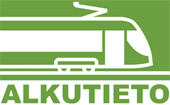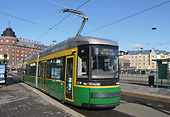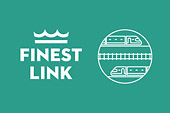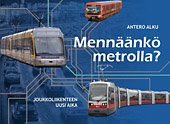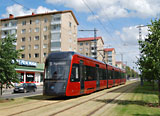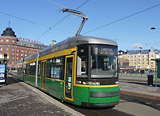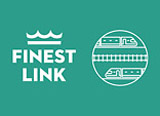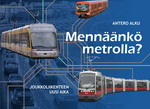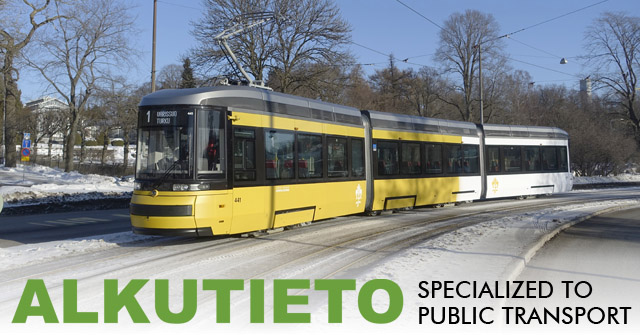
Procurement of the Tampere tram infrastructure and rolling stock
Purchaser's technical advisor in planning the organising and procuring structure, in procurement of the alliance for building the infrastructure and in procurement of the trams during 2010–2017.
The value of the whole project was app. 390 million €, including 285 million € target cost of the infra alliance and 105 million € of the trams and their maintenance contract for 10 years.
Benefit from the work of Alkutieto skills in Life Cycle Approach is app. 140 million € for the City of Tampere in the procurement of the trams compared to the traditional, tram unit price based procurement practice.
The Tampere tramway was completed so that test traffic with passengers started on 10.5.2021 and commercial traffic on two lines on 9.8.2021. The architecture of the tram system, defined by Alkutieto in both the infrastructure solutions and the rolling stock, is well reflected in the completed tramway.
The building of the trackwork started from the beginning of 2017. The procurement of the trams was solved in autumn 2016. But as a consequence of a claim, the contract was signed only a year later in 16.10.2017. The contract includes delivery of 19 trams for 40 years life time and 10 years maintenance contract. The contract includes also options for 46 trams and maintenance up to 40 years period.
The procurement project started after planning phases 2014 by studying the suitable organizing and procuring form. Alkutieto was responsible for clearing the features of a tram system to the consult team. After this phase the work continued with compiling the tendering documents for technical, operational and economical features and requirements. In the vehicle procurement Alkutieto had the main responsibility of the documents. The documents were delivered also in English version by Alkutieto Oy.
Alkutieto carried large responsibility in the tram procurement in the negotiating phase and in evaluating the tenders. During the clame phase the work of Alkutieto continued by compiling the technical and commercial aspects for the documents recuired. After the positive solution in Market Court, tram contract was negotiated and finally signed on 16.10.2017.
Alkuteito Oy worked together with Vison Alliance Partners Oy, Hannes Snellman Attorneys Ltd, Inspira Oy and Sweco PM Oy.
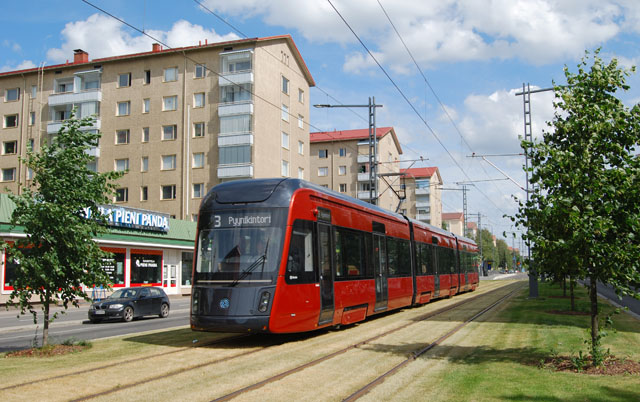
New generation tram procurement in Helsinki
Consulting on the procurement processes for new trams at the tram unit of the Helsinki City Transport with several contracts.
A long term contract started 2008 with concept planning of the new trams, then forwarding to tendering documents, evaluating the tenders, preparing the contract, support for the procurement decision and manufacturing of the prototype trams. Later Alkutieto Oy consulted the type acceptance and commissioning of the trams.The procurement decision for 40 trams was done in 2011. After that 30 base trams and 52 long trams have been purchased as options of the initial contract.
In this procurement process a new low floor tram was developed. The new tram is without the drawbacks experienced with multi articulated trams in Helsinki. Alkutieto participated this concept planning phase that was done in Helsinki City Transport before the actual procurement process.
Later, Alkutieto Oy has consulted on the type approval and acceptance stages of trams.
The delivery of two prototype trams was in 2013. Series production started in 2015 and the deliveries of the options is still going on.
From the beginning of 2020, a new contract has started for HCT's next tram acquisition.
The work was done to the tram unit of Helsinki City Transport. Responsible for the work in HCT was former Head of Rolling Stock Ollipekka Heikkilä.

Master plan phase of the trams for Tampere and Turku
Purchasers technical advisor in planning of tram and procurement of the consult studies during 2010–2014. The work of Alkutieto included the technical specification of the tram system, compiling the tendering documents, procurement of the consult work and the auditing of the work. Alkutieto also participated the finalizing of the master plan. The work started as a work for City of Tampere. The City of Turku participated the master plan phase.
The city council of Tampere made a decision to forward to detailed project planning and procurement of both the infrastructure and rolling stock at 16.6.2014. City of Turku postponed the decison making which is expected to happen in October 2018.
As consults in master plan worked Ramboll Finland Oy and WSP Finland Oy.
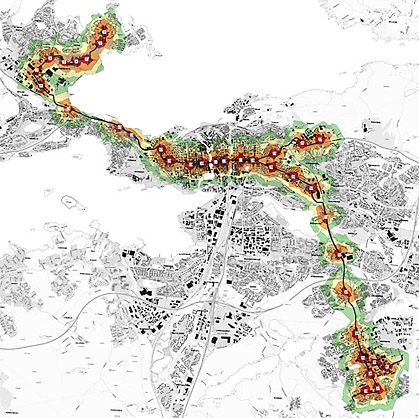
Helsinki–Tallinn railway tunnel
Alkutieto participated in autumn 2017 to the FinEst Link technology challenge competition about a railway tunnel between Helsnki and Tallinn. The base for the competition was an offical preliminary plan for a tunnel connection between the airports Helsinki-Vantaa and Tallinn Ülemiste. In the competition there were 7 participants that were presented in the FinEst Link semninar held at 7.2.2018 in Tallinn. No scores neither prices were given in the competition.
The idea of the Alkutieto work was the busines model of the tunnel organization. Remarkable finding was that the tunnel can be built so that dayli commuting between the cities is possible. Both the volume and the market price for the daily commuting form remarkable share of the operation and income of the tunnel organization. Therefore the starting point for the planning and construction of the tunnel must be first and foremost the ability to serve daily work commuting.
The preliminary business plan and the minimum viable investment for the tunnel was presented in the work. The tunnel project may be extended after the first phase and the service structure can be adjusted according to the realised demand.
Basic concept is built up from the following items:
- As straight as possible tunnel between the railway stations Helsinki city and Tallinn Balti Jaam.
- The pendel trains in the tunnel are part of the commuter train service in Tallinn and Helsinki regions and the trains offer transfer-free service for networks in both regions.
- The tunnel station in Helsinki will be located under the Kaivokatu street and in between the metro tunnel and Pisara railway loop reservation at the level -35 meters, where from the tunnel reaches the current on ground track level for Pasila station before the Nordenskjöldinkatu street railway bridge.
- The tunnel will have also road vehicle shuttle trains for distribution traffic and long distance truck traffic.
- The tunnel fullfills the EU Technical Specifications for Interoperability (TSI) norms for the railway rolling stock of both countries to be able to operate in the tunnel.
For the first phase of the tunnel following numbers of trains and loads were calculated.
Train type |
Trains/day |
Trains/year |
Load/year |
Note |
|---|---|---|---|---|
| Commuter trains | 100 |
32.000 |
13,1 M trips |
Based on current commuting statistics in Helsinki area |
| Road vehicle trains | 17 |
6.200 |
121.000 vehicles |
Vans & trucks on tain |
| Regio trains | 9 |
3.300 |
3,9 ton-km |
App. 5 coach trains |
| Freight trains | 3 |
1.100 |
3,1 M ton |
|
| Sleeping train | 1 |
365 |
0,8 ton-km |
To Warzaw / Berlin |
The operational result of the tunnel is 210 million € per year. The base for the economy is existing and commercially ready railway rolling stock. The shares of the expenses and incomes is displayed below.
Operation and maintenance |
Expenses |
Income |
|---|---|---|
| Commuter trains | 58 % |
79 % (ticket sales) |
| Road vehicle trains | 11 % |
14 % (road vehicle fees) |
| Tunnel | 31 % |
7 % (capacity sales) |
The proposal for the tunnel by Alkutieto differs from the official plan dated 7.2.2018 in the following issues:
- The tunnel connection in Helsinki ends between Helsinki and Pasila stations and is connected to Finnish railway network in Pasila.
- Tunnel is connected to Balti Jaam station in Tallinn from where to west the track is connected to Estonian track network.
- Connections and terminals for the airports of Helsinki and Tallinn are not included in the first construction phase of the tunnel. Instead the airports are served with existing railway lines which the tunnel trains are able to use.
- The tunnel has a dual gauge track of European 1435 mm and Estonian-Finnish 1520/1524 mm gauges.
- Road vehicle trains have terminals in Ilmala in Helsinki and in some of the existing track yards west from Balti Jaam station in Tallinn.
- Freight transfer and gauge adjustment if necessary is organized primarily in Tallinn.
The differences of the Alkutieto concept compared to official plans decrease the cost of the first phase for the following reasons:
- Total length is reduced in Finland when the tunnel rises to ground level
before Pasila. - Total length is increased in Tallinn when the tunnel is built to Balti Jaam
instead of connecting to Rail Baltica by trunk road 1 near Nehatu. - Only one underground station is required in Finland.
- Freight transfer and gauge adjust terminal is required in Tallinn only.
- Road vehicle train depots and terminals are simpler and less expensive.
The competition work of Alkutieto was done by Antero Alku and Esa Nurkka.
Links to report and presentation.
Mennäänkö metrolla? – Let's take the metro?
Sorry, this book is only available in Finnish. But the book still has plenty of photos from around the world.
This book was written in mind that in Finland there is only one region, the Capital Region of Helsinki, that has urban rail transport. Only one example cannot build a realistic understanding of what is modern urban rail transport. There must be available information in local language and written for public.
The book also guides the reader to understand the connection and interaction of the urban structure and transport system. Mainly the book focuses to Europe as a common society and culture structure with Finland.
The 140 pages full colour book is printed in 2007 and copies are still available from Alkutieto Oy. Click the cover image to see the book's own page.
City plan for a former garrison in Tuusula
This plan was made in 2006 as an exercise of city planning studies at the Helsinki University of Technolgy, currently part of Aalto University. The idea of the exercise was a planning contest organized by Tuusula county for finiding ideas in developing a former garrison area in the center of Tuusula. Our work gained second prize.
The idea of our work was to place several villages around tram stops. These villages include all dailiy services around the tram stops so that living without a car is possible for those willing to do so. Nearby areas around the tram stop and services are pedestrian areas. Each village has it's own style offering alternatives for different tastes of living environment.
Tram line offers connections to the centres of Tuusula and to near city of Kerava. From Kerava there is fast commuter train connection up to Helsinki. Outside the scope of garrison area planning our group noticed also the development possibilities outside the contest area and on the area of Kerava. In Kerava the tram line could serve also built areas near Kerava train station. One possibility was a tram train service at the railway branch line from Kerava towards Porvoo. There is already some existing land use but potential for more.
Our work included a fake newspaper article. You may see the article (in Finnish) using this link, PDF 120 kt.
The article is a story of one young family and one elder couple. They have lived in Espoo and Helsinki cities. Young family wanted a safe route for their kids to school. Elder couple wanted more services in walking distance than a bus stop. They both find that living in new villages with their services and proper connections to the outside region is much easier and less expensive than where they used to live. Young family needed two cars in Espoo, here one is enough and needed only for housbands work travelling to airport area. The wife uses tram and train to her work trip to Helsinki. The retired man have finally space and chance to his long dreamed hobbies in the common spaces in the village. His wife still works, but the man can have lunches together with the school students at local social service center.
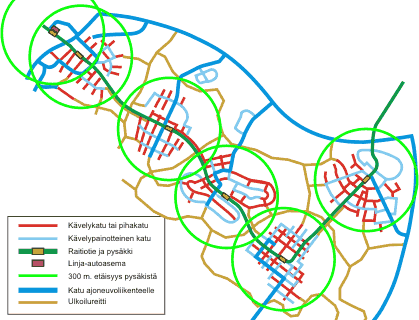
City plan for Santahamina Radioniemi in Helsinki
This plan was made in 2005 as an exercise of city planning studies at the Helsinki University of Technolgy, currently part of Aalto University. It is a suburb of 1500 inhabitans including the required services. A tram line passes through the area. The center of the area is pedestrian area with the tram stop. Streets are shared space with limited car traffic. The Radioniemi peninsula is located in isle of Santahamina south from isle of Laajasalo in Helsinki. The tram line of Radioniemi is an extension plan for the coming tram connection to Laajasalo.
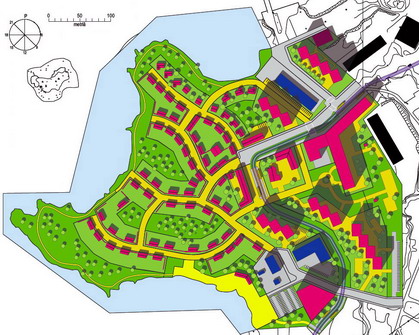
Original page 18.10.2017. Updates 7.8.2021.
